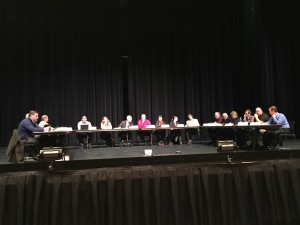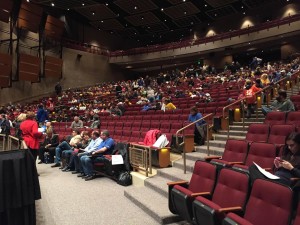The snow was falling and roads were slick last night, but that didn’t stop a couple hundred people from showing up to hear more about the potential second sheet of ice in St. Michael-Albertville and to get the chance to voice their opinion to school district and city leaders.
School board chair Doug Birk gave a brief overview of the proposed arena expansion, then allowed 15-20 minutes of time for the community to comment, limiting speakers to one minute per person and stipulating that equal time would be given to those speaking for and against the expansion project.
Public Comment
A common theme among those speaking against the arena was to say they were not actually against the arena itself. Rather, their grievances were largely related to their desire to put the issue to a community vote or their frustration at the possibility of higher property taxes for individuals and businesses.
The school district, however, has made it clear they will not bring an ice arena expansion question to voters before they make their next school levy request, which is multiple years away. This takes the school referendum funding option off the table, leaving the tax abatement levy as the only viable present choice, especially if they want to be able to use the recently awarded $250,000 Mighty Ducks grant, which has time constraints attached. However, many community members voiced their opposition to raising taxes to fund the second sheet of ice without getting voter approval. On the other side of the issue, supporters countered that city leaders are voted into office for the purpose of making these types of decisions.
Many who opposed the arena expansion came to the microphone with specific numbers to talk about, such as the estimated cost the cities and schools pay for hockey compared with other sports. They noted that each city and the school district pays $15,000 per year to help maintain the ice arena, the school district pays $50,000 per year for ice time for the high school team and that the district and the cities also pay for larger maintenance costs, such as the recent dehumidification system repair, which they say cost $50,000 per entity. Adding these numbers to the possible expansion costs, the opponents say hockey is publicly funded at a much higher rate than other sports and their facilities, such as soccer and baseball.
Those on the supporting end of the issue got the big applauses of the night, with many hockey jersey sporting youth and their parents in the audience. They expressed their gratitude to the local leaders for their commitment to the project thus far and spoke of difficulties with getting their kids to late or early practices in different towns due to ice shortages in STMA. They shared their opinion that adding a second sheet of ice would be one more way that the area would make itself an appealing option for potential residents and businesses. A couple supporters said the facts and figures opponents mentioned were inaccurate, but none gave specific examples on which numbers were incorrect and what the true numbers look like.
Next Steps and Potential Timeline
 After the public comment portion of the meeting ended, school district and city leaders discussed next steps and a potential timeline for the project. The next step would be for all three entities to sign off on the Mighty Ducks grant, which must be executed by Dec. 23. However, many on stage had questions about the time constraints this grant places on the construction of the second sheet of ice, and several felt the timeline would be very aggressive or even too aggressive. Albertville city administrator, Adam Nafstad, said he would go back to the Minnesota Amateur Sports Commission, who operates the grant program, to gain clarification on the timeline.
After the public comment portion of the meeting ended, school district and city leaders discussed next steps and a potential timeline for the project. The next step would be for all three entities to sign off on the Mighty Ducks grant, which must be executed by Dec. 23. However, many on stage had questions about the time constraints this grant places on the construction of the second sheet of ice, and several felt the timeline would be very aggressive or even too aggressive. Albertville city administrator, Adam Nafstad, said he would go back to the Minnesota Amateur Sports Commission, who operates the grant program, to gain clarification on the timeline.
As it reads now, city and school district leaders are looking at a possible completion date of September 2017, less than two years away. If all groups agree to the Mighty Ducks grant (after clarification is sought), the next step would be for the entities to form a design committee to tour other ice arenas, meet with and ultimately recommend an architect and help to develop a concept. The design committee would be made up of nine members, two from each of the four entities (school board, the two cities and the youth hockey association) and one representative from high school hockey. Board chair Birk said these types of preconstruction expenses could be covered by the $40,000 Kraft Hockeyville prize money or current youth hockey money earmarked for the expansion.
The point of no return, the parties agreed, would take place at the end of step six of their 13-point construction plan. At this point the entities would have hard numbers to look at and would vote on a formal resolution to proceed with the second sheet of ice. As it stands today, that step would be reached in April of 2016.
